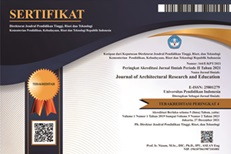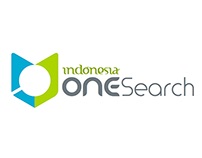CO-HOUSING: A SOLUTION TOWARD SUSTAINABLE SETTLEMENT IN BATAM CITY
Abstract
The increasing population urges the need for space as a place to live in urban areas with limited land. In addition, the population of Batam City are dominated by millennials with low financial ability but high social capital. That can trigger the construction of illegal houses, which sometimes do not meet the criteria for settlements that are slums, reaching fifteen hectares in the Belian Village of Batam City Sub-District. It is necessary to adapt collaborative housing (co-housing) with minimal land use. However, it can provide space as a place to live and socialize as much as possible, including residents in building management. The methodology of this research is a qualitative method with a descriptive approach to the condition of the city of Batam, which is observed directly by paying attention to the strengths, weaknesses, opportunities, and threats, as well as co-housing design considerations. Thus, this study resulted in recommendations for the design of co-housing buildings with facilities and features close to the site, spatial layout and planning that are to the needs of the target user, a property model that is by the user's abilities, and screening and curation process that the user can accept. The sustainability of settlements can also be the result of adapting the co-housing concept in Batam.
Keywords
Full Text:
PDFReferences
Akadiri, P. O., Chinyio, E. A., & Olomolaiye, P. O. (2012). Design of a sustainable building: A conceptual framework for implementing sustainability in the building sector. Buildings, 2(2), 126–152. https://doi.org/10.3390/buildings2020126
Asrinaldi, A., & Yoserizal, Y. (2014). Model kebijakan pengembangan sistem pertahanan sosial berbasiskan modal sosial masyarakat di daerah perbatasan. Masyarakat, Kebudayaan Dan Politik, 27(1), 1–13. https://doi.org/10.20473/MKP.V27I12014.1-13
Awaludin, A. (2017). Sustainable Building Materials adalah Kebutuhan. Seminar Nasional SeNATS 2. https://www.researchgate.net/publication/319214005
Badan Pusat Statistik Kota Batam. (2022). Kota Batam Dalam Angka 2022 (BPS Kota Batam, Ed.). Badan Pusat Statistik Kota Batam. https://batamkota.bps.go.id/publication/2022/02/25/be4b5274297b1accccb70a9b/kota-batam-dalam-angka-2022.html
Batam News. (2018, July 16). Fakta-fakta Rumah Liar di Batam yang Sulit Ditertibkan | Batamnews.co.id. Batam News.
Childs, R. D., Robinson, P., Mcgovern, T. M., & Gingrich, G. (2015). The millennial generation. In Transforming American Governance: Rebooting the Public Square (pp. 307–321). Taylor and Francis. https://doi.org/10.1177/2158244017697158
Chiodelli, F., & Baglione, V. (2014). Living together privately: for a cautious reading of cohousing. Urban Research and Practice, 7(1), 20–34. https://doi.org/10.1080/17535069.2013.827905
Delvina Wijaya, D., & Anastasia, N. (2021). Pertimbangan Generasi Milenial Pada Kepemilikan Rumah Dan Kendala Finansial. Jurnal Manajemen Aset Dan Penilai, 1(2). https://doi.org/10.56960/JMAP.V1I2.23
Fanuel W., Y. (2014). Kajian Estetika Interior Restoran Boncafe Di Jalan Pregolan Surabaya. Jurnal INTRA, 2(2), 7–13.
Farizki, M., & Anurogo, W. (2017). Pemetaan kualitas permukiman dengan menggunakan penginderaan jauh dan SIG di kecamatan Batam kota, Batam. Majalah Geografi Indonesia, 31(1), 39. https://doi.org/10.22146/MGI.24231
Gutiérrez-Mozo, M. E., Parra-Martínez, J., & Gilsanz-Díaz, A. (2021). Extending the architecture of collective housing: Towards common worlds of care. Buildings, 11(4). https://doi.org/10.3390/BUILDINGS11040166
Hayati, A., Utami, A. S. P. R., Bararatin, K., Santosa, H. R., Weichart, G., & Valent, M. K. (2020). Local smart initiatives to enhance sustainable settlement. IOP Conference Series: Earth and Environmental Science, 402(1), 012017. https://doi.org/10.1088/1755-1315/402/1/012017
JPPN News. (2019, August 6). Lahan Makin Sempit, Pembangunan Permukiman di Batam akan Vertikal - Properti di Ekonomi JPNN.com. https://www.jpnn.com/news/lahan-makin-sempit-pembangunan-permukiman-di-batam-akan-vertikal
Krizmane, M., Slihte, S., & Borodinecs, A. (2016). Key Criteria Across Existing Sustainable Building Rating Tools. Energy Procedia, 96, 94–99. https://doi.org/10.1016/J.EGYPRO.2016.09.107
Moniaga, R. G. (2018). Evaluasi Penyelenggaraan Peraturan Walikota Batam Nomor 54 Tahun 2013 Tentang Tata Cara Pemberian Reklamasi Di Wilayah Pesisir Dan Pulau-Pulau Kecil di Kecamatan Batam Kota. Universitas Islam Riau.
Mulyono, A. (2010). Umat Beragama di Kota Batam: di Antara Potensi Integrasi dan Konflik. Jurnal Multikultural & Multireligiu, 9(35), 153–170.
Ramadhan, T., Nirmalasari, D., Ningrum, M., Beatricia, B., & Maahury, H. A. (2019). Implementation of Smart Co-Housing Concept in Middle-Aged Adult Community in Indonesia. Indonesian Journal of Built Environmental and Sustainability, 1(2), 78–89. https://doi.org/10.31848/IJOBES.V1I2.360
Rofiqah, T. (2017). PARTISIPASI MIGRAN DALAM PEMILIHAN KEPALA DAERAH DI KOTA BATAM. KOPASTA: Journal of the Counseling Guidance Study Program, 4(2), 74–81. https://doi.org/10.33373/KOP.V4I2.1440
Sim, M. Z. B. H., Awaluddin, Z. L., Aminuddin, A. M. R., Sarkum, S. A., Sholiha, A. B., & Aziz, A. A. (2021). Architectural Design in Rethinking the Future of Co-Housing in Malaysia. Journal of Design and Built Environment, 21(3), 83–94. https://doi.org/10.22452/JDBE.VOL21NO3.6
Sugiyono. (2017). Metode penelitian kuantitatif, kualitatif dan R&D (26th ed.). Alfabeta.
Törnqvist, M. (2021). Communal Intimacy: Formalization, Egalitarianism, and Exchangeability in Collective Housing. Social Forces, 100(1), 273–292. https://doi.org/10.1093/SF/SOAA094
Tutuko, P., Subagijo, E., & Aini, N. (2018). The planning and design of residential facilities in poor areas with limited land: A case study of Muharto residential area along the Brantas River, Malang, Indonesia. International Review for Spatial Planning and Sustainable Development, 6(3), 22–36. https://doi.org/10.14246/irspsd.6.3_22
Wang, J., Pan, Y., & Hadjri, K. (2018). Exploring Collaborative Design and Sustainable Living in British Cohousing Communities. Asian Journal of Behavioural Studies, 3(14), 30. https://doi.org/10.21834/AJBES.V3I14.163
Widodo, B., Lupyanto, R., Sulistiono, B., Harjito, D. A., Hamidin, J., Hapsari, E., Yasin, M., & Ellinda, C. (2015). Analysis of Environmental Carrying Capacity for the Development of Sustainable Settlement in Yogyakarta Urban Area. Procedia Environmental Sciences, 28, 519–527. https://doi.org/10.1016/J.PROENV.2015.07.062
World Economic Forum. (2017). Migration and Its Impact on Cities In collaboration with PwC.
Zubaidi, F. (2012). THE CONCEPTUAL OF SUSTAINABLE SETTLEMENT WITH PARTICIPATORY APPROACH. Journal of Architecture&ENVIRONMENT, 11(2), 199–210. https://doi.org/10.12962/J2355262X.V11I2.A496
DOI: https://doi.org/10.17509/jare.v4i2.51519
Refbacks
- There are currently no refbacks.
Copyright (c) 2022 Journal of Architectural Research and Education

This work is licensed under a Creative Commons Attribution-NonCommercial-ShareAlike 4.0 International License.

This work is licensed under a Creative Commons Attribution-ShareAlike 4.0 International License.








